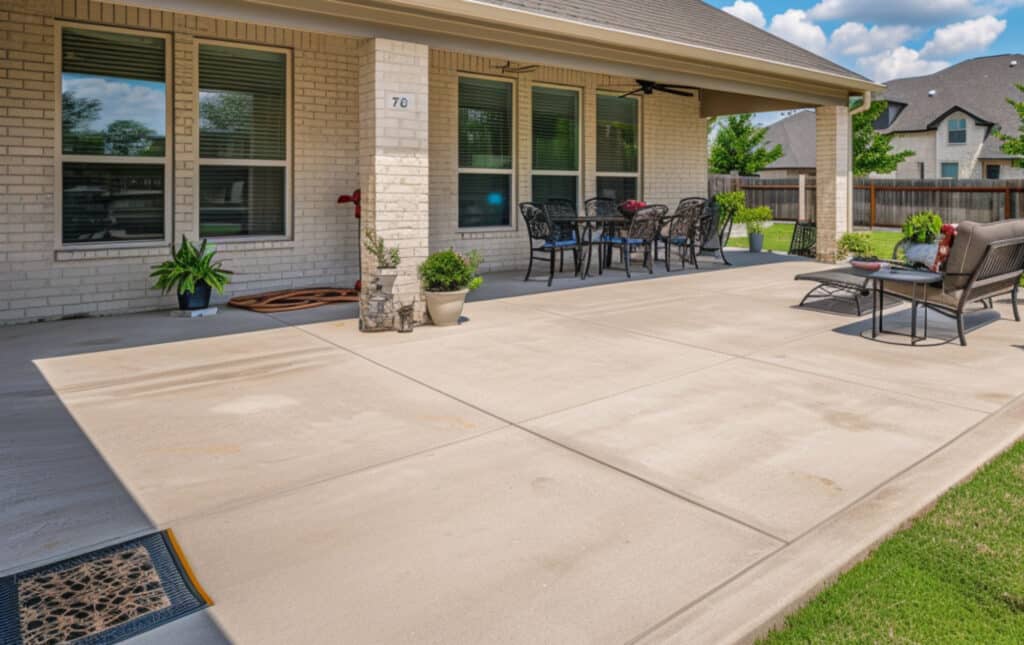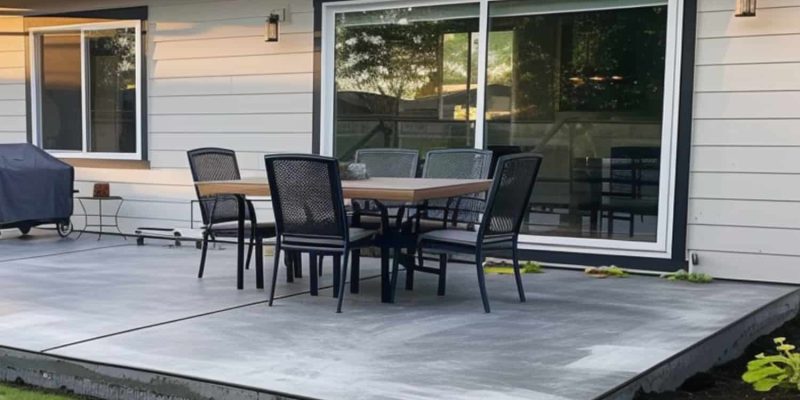Are you thinking about adding a concrete patio to your backyard? Picking the right thickness for your concrete patio is a big deal. It makes sure your patio lasts a long time, looks good, and follows the rules of our city. In this guide, we’ll walk you through everything you need to know to make the best choice for your home. Let’s dive in and find out how thick your concrete patio should be!
Understanding Concrete Patio Thickness
What’s Patio Thickness?
Think of patio thickness like the foundation of a house. It’s how thick or thin the layer of concrete is when you pour it to make your patio. This thickness is super important because it helps your patio stand up to all kinds of weather, wear, and tear.
Why It Matters
A patio that’s too thin might crack or break under pressure, but one that’s too thick could cost you more money than necessary. We aim for a sweet spot that keeps your patio safe and sturdy for BBQs, family gatherings, or just relaxing.
Standard Recommendations
Most of the time, experts say a concrete patio should be about 4-6 inches thick. This range is good for most patios in homes like ours in Waco, Texas. It’s thick enough to be strong but not so thick that it wastes your money.
Factors Influencing Patio Thickness
Load Requirements
Think about what you’ll use your patio for. If it’s just for sitting and enjoying the sun, a standard thickness is fine. But, if you plan to have lots of people over or put heavy stuff on it, like a hot tub, it needs to be thicker to hold that weight without problems.
Soil and Environmental Conditions
Our soil in Waco can vary a lot. Some areas have soil that moves or settles over time. If your backyard has this kind of soil, your patio might need to be a bit thicker to stay level and crack-free. Also, Texas weather can be tough on patios. A thicker patio can handle rain, heat, and cold better.
Reinforcement and Material Choices
Adding steel bars (rebar) or mesh can make your patio stronger. Even if it’s not super thick, this can help it carry more weight and last longer. The kind of concrete mix you use also matters. Some mixes are made to be stronger and can do well even if they’re not as thick.
Adhering to Local Building Guidelines
Why Following the Rules Matters
In Waco, like in any city, there are specific rules about building things in your yard, including concrete patios. These rules help make sure that your patio is safe, doesn’t negatively impact the environment, and fits well with your community. Not following these rules can lead to fines or having to redo your patio.
Finding and Understanding Local Guidelines
You can find Waco’s building guidelines on the city’s website or by calling the local building department. These guidelines will tell you how thick your patio needs to be, if you need to add anything special to the concrete, and how to make sure your patio drains water properly. If the rules seem confusing, don’t worry! You can ask the department for clarification or talk to a local contractor who’s used to working with these guidelines.
Design Considerations for Patio Thickness
Aesthetic Impact
The thickness of your concrete patio doesn’t just affect its strength and durability; it also plays a big role in how your patio looks. A thicker edge, for example, can give your patio a more solid, grounded appearance. If you’re going for a sleek, modern look, keeping the edges clean and at the recommended thickness is key.
Design Flexibility
The thickness of your patio can also influence the design options available to you. With a thicker base, you can consider adding features like built-in seating, fire pits, or even outdoor kitchens. These add-ons require a strong foundation to be safe and functional, so planning for a little extra thickness might be necessary.
NOTE
Considering the design implications of patio thickness ensures that your outdoor space is not only functional but also visually appealing. It’s important to balance aesthetic desires with practical requirements, ensuring your patio serves both as a durable structure and an attractive element of your home.
Practical Guide to Measuring and Achieving Desired Thickness

Preparation and Planning
Before you start mixing concrete, you need a solid plan. Measure the area where your patio will go and think about the shape and size. Mark it out with stakes and string to see it clearly. This step helps you know exactly where your patio will be and how much concrete you’ll need.
Measuring and Pouring Concrete
- Digging the Area: First, dig the ground where your patio will be. You’ll want to go down a bit deeper than your planned thickness to make room for a gravel base. This base helps with drainage and adds extra stability.
- Adding Gravel: Fill the dug-out area with about 4 inches of gravel. This layer is part of your overall thickness plan, so include it in your calculations.
- Setting Up Forms: Use wooden boards to create a frame around your patio area. These forms will hold the concrete in place and shape it to the exact thickness you want. Make sure they’re level and sturdy.
- Pouring Concrete: Mix your concrete following the manufacturer’s instructions. Pour it into the forms, spreading it evenly. A standard thickness for a patio is about 4-6 inches on top of the gravel layer.
- Leveling: Use a long board to smooth out the concrete, making it level across the top. Check with a level tool to make sure it’s even.
Finishing Techniques
After pouring, you can smooth the surface with a trowel for a clean look or texture it for extra grip and style. Let the concrete set and cure as recommended before removing the forms and using the patio.
Maintenance and Longevity
Regular Maintenance Tips
Keeping your concrete patio in top shape doesn’t have to be a big chore. Here are some simple things you can do:
- Clean Regularly: Sweep off leaves, dirt, and debris to keep the patio clean. Wash it with a hose or a gentle cleaner to keep stains away.
- Seal the Surface: Applying a concrete sealer every few years can protect your patio from water, stains, and wear. It helps keep your patio looking new and can prevent cracks.
- Check for Cracks: Take a walk on your patio now and then to look for any cracks or damage. Catching problems early can make fixing them easier and cheaper.
Dealing with Wear and Tear
Even the best-built patios can show signs of wear over time. If you see small cracks, you can fill them with a concrete crack filler. For bigger issues, it might be best to call in a professional. They can assess the damage and suggest the best way to fix it, keeping your patio safe and beautiful for years to come.
Conclusion
Choosing the right thickness for your concrete patio in Waco, Texas, is more than just following a standard guideline; it’s about understanding your patio’s specific needs, local building codes, and how you want your outdoor space to look and function. By considering factors like load requirements, soil conditions, and design aspirations, you can ensure your patio is both beautiful and built to last. Remember, a little planning and maintenance can go a long way in enjoying your outdoor space for many years.

